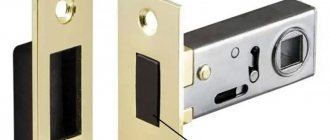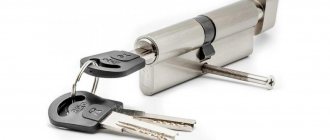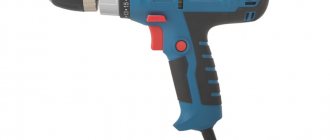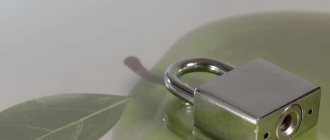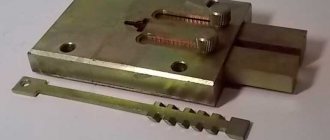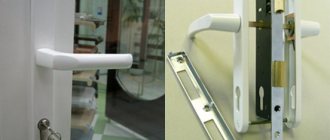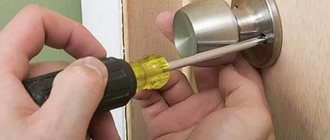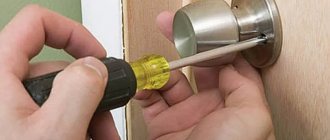One of the necessary elements of fittings is a handle, since if it is missing, it is almost impossible to open and close the door. The apartments use special mechanisms with a latch. The latter works as a locking device. To ensure that the sash fits well to the frame, such a mechanism is quite sufficient. However, if you need to lock interior doors in a room, you need a real, full-fledged lock. It happens that in the event of a breakdown or the need to replace a mechanism for any other reason, it must be disassembled and removed. How to disassemble a door lock? Let's look at everything in order.
How to disassemble the locking device of an interior unit
In many cases, when the lock of interior doors begins to malfunction, its functionality can be restored. To do this, it is enough to carefully remove and disassemble the device, and then perform maintenance or repair operations. An old lock may have parts left that can be used to replace faulty components in similar models of other locking mechanisms. If you understand the structure of locks and have the appropriate tools, you can restore their functionality without involving a specialist from a lock company.
When it becomes necessary to disassemble the lock
In most cases, the internal door structures of private houses, apartments, offices and other premises are equipped with inexpensive locks that have a simple design and a low degree of security. The purpose of such products is to keep the canvas closed. Since such mechanisms are not designed for high loads, they are assembled from low-quality components.
During operation, the mechanism begins to malfunction, resulting in jamming of the tongue, malfunction of the handle and its fastening elements, jamming or incomplete insertion of the key. The reasons for their occurrence may be:
- accumulation of dust and small metal shavings formed during wear of rubbing parts;
- insufficient quantity or thickening of the lubricant, due to which significant force must be applied to operate the lock;
- entry of foreign bodies into the housing, interfering with the normal operation of the locking device;
- jamming of the latch handle;
- a fragment of a key stuck inside the larva.
Many of these problems can be resolved by dismantling, disassembling, repairing or servicing the lock. The owner who decides to restore the functionality of the locking device on his own should be aware that not all models can be disassembled.
Reasons for replacement
Fittings should be replaced for a number of reasons:
- If the structure is broken.
- If the fastening element is loose.
- Loose fit of the fittings to the surface of the door leaf.
- The owner encountered a fastener failure.
- The fittings are outdated models, not made in accordance with the stylistic decisions of the room.
What locks are installed on interior doors?
To equip doors that close entrances to rooms, the following are most often used:
1. Handles with a tongue. The simplest design, the operating principle of which is based on the release of the tongue that holds the door closed when the handle is pressed.
2. Latch mechanism. On the outside of such a locking device there is a key hole or a plug is installed. The door leaf locking mechanism is located inside. A device with a latch, designed in the form of a round knob handle, is popular among property owners. The system is activated by rotating the ball on its axis through a certain angle. Depending on the model, they can be additionally equipped with latches and cylinders built into the handle. There are products that are equipped with a push handle.
3. Locking devices with limited access, having a certain degree of secrecy, as a rule, cylinder or lever type. They can be overhead or mortise. The complexity of the secretion is determined by the number of movable lever plates with figured cutouts or the number of pins of the larva with the configuration of the grooves between them.
4. Electromagnetic and electronic protective systems. In most cases, such mechanisms are used as additional ones and are installed on doors covering the entrances of work and office rooms, storage areas for valuable items and other secret rooms. A source of electrical energy is required for operation. This kit includes sensors, a powerful electromagnet, a metal plate, connecting wires and a control unit. Due to the complex electronics involved and the potential for electrical shock, disassembling this type of device yourself is not recommended.
Types of locking mechanisms
The most popular mechanism is the mortise mechanism. The device is installed in the door, limiting access to the core. There are several types of locks with different fittings.
The overhead mechanism is also popular. It requires a more powerful door leaf. Since the interior door is rather weak for it, it is, as a rule, not used in this case.
Everyone knows padlocks. This is a design that is locked thanks to hinges attached to the door. The reliability of such a lock is not very high, since it is in plain sight and if physical force is used, it can simply be torn off. Therefore, inside buildings, a padlock is installed on the doors of storage rooms or warehouses where things of little value are stored.
How to disassemble the lock yourself
Before disassembling a mechanical type device, it is necessary to prepare the tools and materials that will be required for the work:
- screwdriver with attachments or screwdrivers (phillips and flat);
- pliers and tweezers;
- thick needle or awl;
- a set of small open-end and hex keys;
- oiler with lubricant;
- WD-40 liquid;
- old toothbrush or brush;
- clean cloth.
Since the sequence of disassembling devices of various types has a number of differences, it is recommended to record all operations on a smartphone or camera. A pre-prepared sheet of white paper will help you avoid losing small details during work.
The sequence of disassembling the mechanism with a latch (socket, with a classic L-shaped or ball-shaped handle):
1. On the bottom or side of the handle, unscrew the recessed fixing screw with a hex key. On some models this can be done using a screwdriver.
2. Disconnect the decorative trim by turning it several turns along the thread.
3. Unscrew the fixing screws of the locking mechanism.
4. Unscrew the fastening elements of the latch plate from the end of the doors and remove it.
5. Carefully remove the mechanism from the groove by pulling it.
In the case when the interior door has a mechanism with a lock located inside the handle, proceed as follows:
- Using a thin screwdriver, carefully pry the decorative trim off from different sides and then remove it.
- Unscrew the screws securing the inner and outer parts of the locking mechanism, and then carefully remove the handle from the outside of the doors. To remove the fittings, it is recommended to hold the stopper that secures the handle with the thin end of an awl.
- Remove the protective plate from the end of the doors by unscrewing the fastening screws.
- Remove the core of the device.
When a device with a round handle is installed, the operations are performed in the following order:
1. Insert the thin end of the awl into the hole in the cover. Lock it by pressing the spring-loaded latch. Disconnect the ball handle.
2. Carefully pry up the decorative trim and detach it.
3. Unscrew the screws securing the mechanism and remove it from the groove.
4. Remove the core of the mechanism. If the lock is activated and does not allow the core to be removed, insert the key into the hole and turn it, simulating closing.
Be careful!
As already mentioned at the beginning of the material, the main reason for dismantling the locking device is its breakdown. Therefore, when purchasing a new lock, pay attention to several main factors:
- burglary resistance class;
- durability;
- performance characteristics;
- the name of the brand that released the model you liked.
This will help you choose a really high-quality locking mechanism that will function properly for many years, saving you from having to look again for information on how to remove a door lock .
We wish you good luck in dismantling the old constipation and choosing a new, high-quality model!
How to extend the life of a lock
Timely maintenance of the mechanism and its minor repairs will help ensure the locking device of the interior door has the maximum possible service life. Maintenance consists of partial or complete disassembly of the product, timely cleaning of accumulated dust, chips and other contaminants, and replacement of worn-out parts.
In some cases, the owner has to deal with lever and cylinder mechanisms that have a certain degree of secrecy and a more complex design. To service them and replace components you must:
- Unscrew the screw securing the handle with a hex key, and the screw securing the cylinder at the end of the door using a screwdriver. After inserting the key into the hole, it is easy to pull it towards you. When resistance appears, turn the key until the tongue of the cylinder disengages from the mechanism.
- Unscrew the screws securing the decorative trims with handles and disconnect them. Remove the handles, pull the square out of the mechanism, remove the mechanism body.
- Unscrew the screws securing the housing cover and remove it. Clean the hole for the housing at the end of the blade from dust and chips. Inspect the handle mechanism, lubricate the return springs and travel stops. Check the operation of the cylinder and lubricate it by adding oil using a syringe.
- Clean the internal elements of the mechanism from dust and chips using a brush. Check the position and condition of rods and springs. If necessary, replace worn out parts. Apply oil to moving parts. Place the cover in place and tighten it with screws.
- Reassemble the mechanism in the reverse order, securely fasten all elements with clamping and mounting screws. Check the ease of movement of the crossbars and latch tongue when the doors are open, and the tightness of the closure of the door leaf. If necessary, adjust the position of the strike plate.
In the event that the owner is not confident in his capabilities, does not have sufficient knowledge and experience in disassembling different types of locking mechanisms, or the necessary tools for the job, he can always turn to specialists from a specialized company for help.
Safety precautions
When dismantling and installing fittings, you should be careful. Do not put your hands under the tool to avoid injury.
If it is difficult to cope with the process on your own, it is recommended to turn to the services of specialist companies. They will quickly cope with the task and bring their plans to life. The technician will select the most suitable fittings and install them in place.

